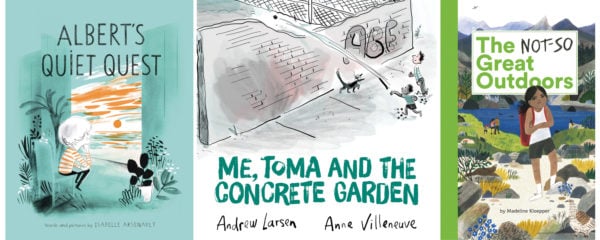
Kids seem to have it made in the summer, but they are rarely in charge of their vacation plans. Three new picture books show the disappointment of being stuck somewhere seemingly unpleasant when school is out.
Albert’s Quiet Quest, the second book in Isabelle Arsenault’s Mile End Kids series (the first was Colette’s Lost Pet), starts with Albert storming out of his noisy Montreal home to read in the alley near a discarded painting of a beach. When his neighbourhood friends arrive, he sees them both in reality and as part of the painting’s imaginary seaside world. The fantasy falters as more kids come, the noise grows, and Albert explodes. His pals take the outburst in stride. Instead of reciprocating Albert’s anger, they head off to find books of their own – and read in silence with him.
Told entirely in dialogue, the story unfolds in a series of panels, hand-lettered speech bubbles, and double-page spreads. Arsenault’s blue, orange, and grey colour palette, whispery shading, and delicate watercolours are wildly different from Charles Schulz, but the Mile End crew feel a bit like the Canadian Peanuts gang; they live in a world where adults are only implied and each member of the beguiling ensemble cast is wholly engaging (here’s hoping that blunt-banged Beth and her beloved black cat get their own book next).
Like Albert, Vincent is also unhappy with an urban summer in Andrew Larsen and Anne Villeneuve’s Me, Toma and the Concrete Garden. That is until he befriends Toma, a neighbourhood kid who helps him pass the time by throwing dirt balls into an empty lot. When it’s revealed that the dirt balls actually contain seeds – and the boys have unintentionally planted a garden – Vincent starts feeling more optimistic about his vacation plans. Villeneuve successfully portrays the city as an initial disappointment without making it all-out ugly, opting for lots of white space, pale greys, pinks, and blues. As the unexpected garden blooms, so do the colours, building up to a final spread filled with green and brown. The accompanying story doesn’t flow quite as smoothly: the text is too long to create any surprise about the unexpected seeds and too short to address some dangling bits of narrative. For instance, Vincent and Toma label a fairly innocuous neighbour “Mr. Grumpypants” after he inquires once about the dirt balls, and though this seems to hint at the beginning of an intergenerational tension or friendship, the build-up instantly dissolves once the garden grows.
While some kids feel stuck in the city, Madeline Kloepper’s unnamed protagonist is dreading a rural getaway in The Not-So Great Outdoors. The fact that she has been coerced into nature is clear from the start as she proclaims, “I have no idea why we have to ‘venture into the great outdoors’ this summer.” This is a humorous book that starkly contrasts the girl’s complaints with the undeniable beauty all around her. A velvety night sky and bonfire glow as she bemoans the lack of electricity, a waterfall sprays as she scoffs at the lack of fountains, and as she stands on a beach full of broken logs and large boulders she whines, “There aren’t even any playgrounds.”
This concept demands that the illustrations be lush and inviting for readers to see a different perspective from the unhappy main character – and Kloepper delivers. Done entirely in double-page spreads, the mixed-media art is full of texture and tiny details that make the outdoors look fun and entertaining, including a surprised Bigfoot running away from a cave. This is an unexpected love letter to nature that explicitly encourages children to consider the relationship between text and pictures.
Like Albert and Vincent, the girl in The Not-So Great Outdoors eventually comes to appreciate her surroundings. But a change of heart does not negate that all three kids initially feel hesitation or grumpiness at the beginning of the season. These are honest summer books, showing that beautiful weather does not always bring positive feelings – at least not right away.
 Contact us via email
Contact us via email
